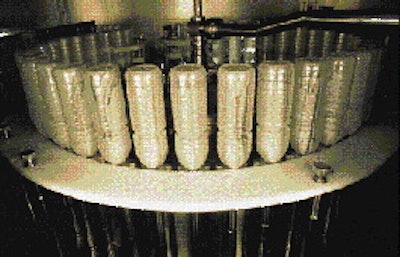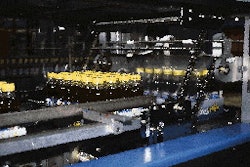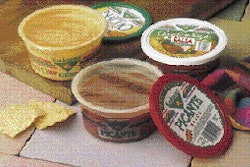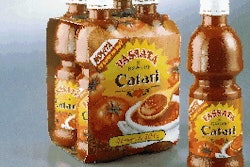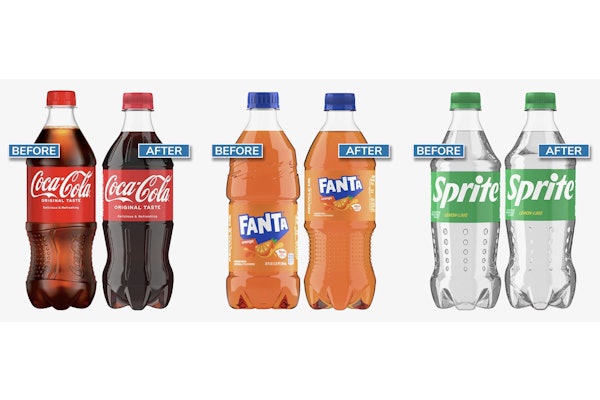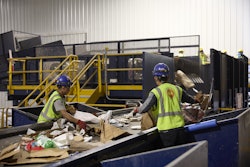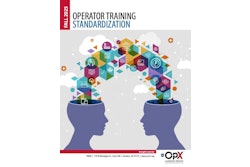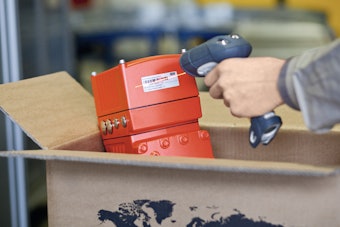Aseptic filling of food and beverages into bottles made of polyethylene terephthalate is just beginning to gain a toe-hold in the U.S. In Europe, however, where installations are more numerous, the talk centers on improving these aseptic filling technologies.
A leader in aseptic "envelope-pushing" is Boschi Luigi & Figli of Felegara, Italy. Tomatoes are BLF's core business. Between the Felegara plant and another BLF plant in Fontanellato, the company processes 350ꯠ tons of tomatoes during the tomato season.
A key strategy over the past decade has been to broaden the company's product lines so that the two plants can be more efficiently utilized beyond the 40-day period when the tomato crop comes in. Fruit juices and teas have been added, some in cans, some in glass, some in aseptic brick packs. Virtually all are packed under well-known brands, including Lipton and Parmalat.
With consumers showing more and more interest in PET bottles, BLF launched hot-filled teas and juices in PET in 1994. But according to Franco Scaramuzza, plant director of BLF's Felegara facility, "We found the heat-set bottle too expensive." Scaramuzza says while a 1/2-L hot-fill PET bottle weighs 40 g, the same-size bottle BLF now fills aseptically weighs just 23 g. With PET resin prices at an all-time high in 1994, BLF got to thinking about lighter, more cost-effective alternatives.
One such alternative was brought to BLF by the food equipment manufacturer Rossi & Catelli of Parma, Italy, whose engineers were working on a prototype system for aseptic filling of PET bottles. "They approached us to see if we were interested," says Scaramuzza. Not long after, this rotary-style prototype machine was installed at BLF's Fontanellato plant. Today it's used for aseptically packaging teas into 11/2-L PET bottles with 28-mm threaded polypropylene closures. Shelf life on tea products is 12 to 18 months, while juices and sports drinks achieve six months.
On to the next generation
Following BLF's experience with the prototype aseptic PET system, says Scaramuzza, "We were asked if we'd like to install a second line, this time in our Felegara plant."
The timing couldn't have been better. BLF had just lost some private-label packing business from beverage marketers who wanted their product in 500-mL PET bottles, but didn't want to pay the upcharge for a heat-set bottle. A BLF competitor with a newly installed aseptic PET system won this business.
The system proposed for BLF's Felegara plant, unlike the dedicated 11/2-L system at Fontanellato, could fill 1/2-L as well as 11/2-L bottles. So management agreed to install the new system. It went into commercial production in March 1998.
By this time, Tetra Pak Plastic Packaging (Geneva, Switzerland) had become the worldwide distributor of the Rossi & Catelli-designed rotary aseptic PET filler. In fact, it was Tetra Pak that was responsible for selling, installing and servicing the new rotary system at BLF's Felegara plant. Tetra Pak not only installed the filler/capper system, it also designed and integrated the upstream and downstream equipment needed to make a completely automated packaging line capable of operating at 200/min. The turnkey responsibility was attractive, says Scaramuzza. "They even provide the preforms," he points out.
Feeding bottles to BLF's aseptic PET line are two of Tetra Pak's X-6 linear stretch blow-molding machines. Tetra Pak preforms are sent to the Felegara plant in corrugated gaylords. Walking through the raw materials warehouse at BLF's Felegara plant and comparing inventories of heat-set PET bottles with gaylords of bottle preforms, another advantage of in-house blown PET bottles becomes clear: Nearly 11ꯠ 1/2-L preforms in a gaylord occupy approximately the same space as a palletload of 1ꯠ heat-set bottles.
"You can imagine the benefits in handling, receiving, transporting and warehouse storage," says Scaramuzza.
Each blow molder is fed preforms automatically from a floor-level hopper and uses transport mandrels to take bottles six-across through heating lamps and then into the six blow molds. Replaceable shoulder inserts for both bottle sizes can be used for customers who want to customize their bottles with their name or logo.
Transport by air
Emerging from the blow molders, bottles are air-conveyed, suspended by their neck rings, a considerable distance to an adjacent room where the rotary aseptic filler sits. The Berchi (Parma, Italy) conveying system includes a combiner that smoothly merges the two separate flows of bottles into one. The sheer length of the air conveyor provides about four minutes of accumulation time between blow molding and filling.
The filling system consists of three separate chambers followed by a capper. In each chamber, sterile air flows constantly from top to bottom to minimize contamination.
Both the 1/2- and the 11/2-L bottles are handled in the same manner as they move from one chamber to the next. Bottles enter the first chamber by way of a starwheel/feedscrew/starwheel infeed. The first starwheel guides bottles into a cylindrical inverter that turns each bottle 180° and then hands it off to a feedscrew. While held in the feedscrew, the inverted bottles rest on a transfer plate.
At the end of the feedscrew is another starwheel and, inside the first sterile chamber, a carousel with 40 notches around its perimeter. Each bottle neck friction-fits into a notch so that the carousel can take the inverted bottles around a circular path. Along the way, one of 40 individual spray rods enters each bottle and sterilizes the interior with a mist of oxonia solution. A mix of 41/2 L of oxonia and 501/2 L of water is heated to 70°C (158°F) to achieve the proper sterilization.
A starwheel pulls bottles from the sterilizing carousel and transfers them to the friction-fit notches of the rinsing chamber's rotary carousel. Following a sterile water rinse, a starwheel/feedscrew combination inverts bottles so they rest once again on their bases on a transfer plate. A starwheel diverts each onto one of 40 mechanical grippers on the rotary carousel inside the filling chamber. Each bottle is lifted toward the counter-pressure filler's nozzles, which allows product to flow into the bottle.
Sterile capping
Another star/feedscrew combination guides filled bottles into a 12-head rotary capper. Like the bottles, the caps also pass through oxonia sterilization and sterile water rinse before they're applied.
In the event of a bottle jam, the system is shut down while operators correct the problem through doors on the sides of the chambers. If they're able to correct the problem quickly without touching machine parts, a 30-minute sterilization mode can regain the necessary level of asepsis to go back into production. If the problem is more complex, a complete five-hour clean-in-place cycle is needed before production can resume.
With BLF's Fontanellato plant capable of handling only 11/2-L bottles, most of the output coming from the Felegara plant has been in the 1/2-L size. But Felegara has run the larger size when necessary. This line also has the flexibility to handle bottles having either 28- or 38-mm finishes.
If given a choice, says plant director Scaramuzza, he'd prefer to stick with the 28-mm finish. But some customers like the easy-to-gulp quality of the larger bottle finish, so BLF has little choice but to offer it. Changing from one neck finish to another, however, is no piece of cake.
"It takes no less than three days, using skilled people, to change the line from one finish to another," says Scaramuzza. "It starts at the blow molding machines and continues right through to the palletizer."
Now that the Felegara line has been running for a full year and sales of BLF's aseptically filled teas and sports drinks in PET bottles are climbing, the possibility of a second system being added has entered the discussion stages. Should that happen, says Scaramuzza, it would certainly make sense for each system to be dedicated to a single cap diameter.
Exiting the capper, bottles are carried on a slat chain conveyor to a roll-fed labeler supplied by B&H (Ceres, CA). Biaxially oriented PP film labels are gravure-printed in four colors. Bottles are conveyed next through a machine vision inspection system supplied by Logic and Controls (Parma, Italy). It checks for missing or cocked caps, wrong fill levels, and missing or skewed labels.
Next is a shrink-film bundler from SMI, which is represented in North America by Francis W. Harkness (Vaudreuil-Dorion, Quebec, Canada). Adding no paperboard tray or support for either bottle size, the machine collates and shrink-wraps six-packs of the large bottles and 12-packs of the smaller ones.
Further downline, a Comag (Castrocielo, Italy) machine heat-seals a plastic carrying handle to bundles of 11/2-L bottles. All that remains is automatic palletizing on a system supplied by Berchi.
From the beginning of the project, BLF emphasized how important it was that the aseptic PET system at Felegara be efficient and reliable. According to Scaramuzza, it's both. He points out that if the system ran at 100% efficiency, it would produce 288ꯠ bottles in 24 hours. "On several occasions," says Scaramuzza, "we have obtained from 230ꯠ to 270ꯠ bottles in a 24-hour period."
